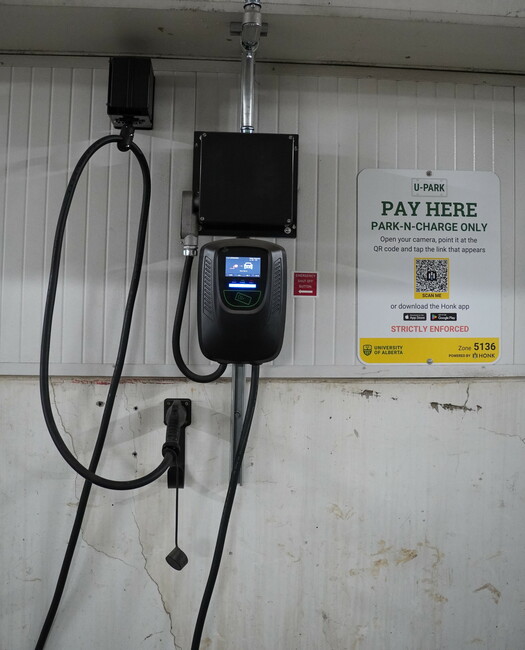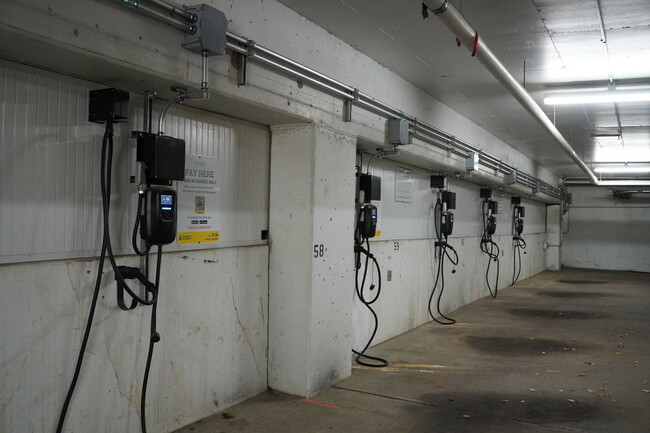Electrifying the Charge: An EV charger journey
Posted on
Zhongyi Quan next to his Swift Charge EV charger
Zhongyi Quan is a trailblazer in the Electric Vehicle (EV) charger industry. His company, Swift Charge, is poised to be one of the top charger companies in North America. And he’s building and testing the chargers right here at the University of Alberta.
Three years ago, Zhongyi was a few months into a postdoctoral position working on a Future Energy Systems project at the University of Alberta, and he had a very different idea of where his life was headed. “I had just finished a visiting research position in Germany in 2020, and was barely back for a month before the covid pandemic hit. Before that, I thought my path was bound to academia, research and teaching.”
That was when Zhongyi applied for the GreenSTEM Award, now known as the Innovation Catalyst Grant. The Grant program offers an entrepreneurial fellowship for recent graduate students from a science, technology, engineering or math discipline. Over the course of two years, post graduate students are mentored as they develop and commercialize their unique and innovative science-based design.
For Zhongyi, the Grant was an introduction to running a business and helped him grow his communication skills. “Although I’m still doing research and development, I’ve had to learn a lot –– and not all of it has been technology-related. I didn’t know there was so much to running my own business and it’s been challenging to learn how to communicate with people and audiences very different from the ones I was used to in my graduate studies.”
When it came to choosing a focus for a grant proposal, it took him a minute to commit to a single inspiration—he went back and forth between solar photovoltaic inverters and electric vehicle (EV) chargers—but eventually settled on the chargers because of the market opportunity. “Chargers offered a lot more opportunity with the technology and flexibility when it came to commercialization. That was something that the program pushed me to consider: how can I be successful after the research was done?”

So Zhongyi began developing his business alongside his technology. His business plan was inspired by a simple problem of cost: current electric charger designs require significant amounts of power to charge an electric car and few, if any, of our buildings have the appropriate infrastructure required to consistently support such a high electricity demand. Electrical infrastructure would need to be significantly upgraded with huge associated costs and not every organization can afford to do so, especially when there isn’t a high demand for EV chargers.
So what’s unique about the chargers?
Zhongyi and his research team are working on two primary designs: the first aims to reduce power usage by topping up partially-charged cars––for instance, if you plug in your car during the day at work. This design uses algorithm-controlled software to reduce the power usage by controlling amounts of power over longer periods of time and allows electrical systems to prioritize charging stations based on how long the chargers have been in use, meaning that the longer an electric car has been charging, the less power it will consume. Unlike the chargers found at commercial-scale charging stations, or even those found in private homes, this design was not intended to support a full charge—but that means less burden on the facilities where they’re installed, and some power for more EVs.

The second design is still a prototype, but this charger is supported by an on-board rechargeable battery and is what Zhongyi calls a “fast charger”. Like the first design, its primary purpose is to support electric vehicle charging without significantly increasing a building’s electricity demand. However, because the battery stores additional power, this design can support charging in less time—in one hour instead of six!
The batteries used in this prototype are most commonly lithium-ion batteries due to availability, though Zhongyi refers to his company as “battery agnostic”, meaning different types of batteries better suited to rapid charge and discharge can be incorporated as they become available. Since the alternative design is supported by a battery, the charger can also function bidirectionally. This means that when not in use, the fast chargers can function as mini generators and return energy to the building in the form of electricity. Other uses can include supporting energy storage for solar cells and even energy efficiency solutions for buildings.
From a business perspective, Zhongyi explains that the ability to support bidirectional charging was a no-brainer: “Batteries degrade over time anyway and there need to be other ways to use the battery for the technology to be viable. It has to be a complete enterprise solution that’s cost effective. These energy solutions have to be future-proof.”
Another unique feature of the Swift Charge chargers is that they’re designed and assembled on the University of Alberta campus. “We’re working with a production company, who builds the parts that we need. Then they ship us the parts and we assemble the chargers right here in our lab. After that, we install them in their final locations.” Zhongyi says. “This process actually helps us keep costs down, too, which is an added bonus.”
Persuading the University and What’s Next
Uniquely, Swift Charge won’t be selling to businesses. Their approach is to enter a partnership with a client that will host the chargers on site. The chargers will be owned, operated, and maintained by Swift Charge, and EV drivers will pay Zhongyi’s company directly. From there, a small fee is returned to the host business to cover the cost of electricity.
“This was actually the most cost-effective way to install EV chargers on site,” Zhongyi explains. “Plus, then we can manage the technology for maintenance, or in the case anything goes wrong.”
While Zhongyi currently has 3 patents pending on his technology for hardware and design, his very first client and host site was the University of Alberta. Fortunately, the University was already looking into installing electric vehicle chargers when Zhongyi made his approach: “We proposed a solution to conduct research on the chargers while they were being installed, and to do so at a lower cost. It just worked out well.”
Zhongyi’s future plans involve developing potential business partnerships and he’s already meeting with investors: “It’s stressful and exciting, but I’m looking forward to bringing more good news.”

For now, students and staff at the University of Alberta can take advantage of the Swift Charge chargers when charging their electric vehicles at the Windsor and Stadium car parks on the University of Alberta North campus.
"It makes me proud to see people really using the technology and seeing that it works. It's pretty awesome and rewarding, like our work is really making a difference."